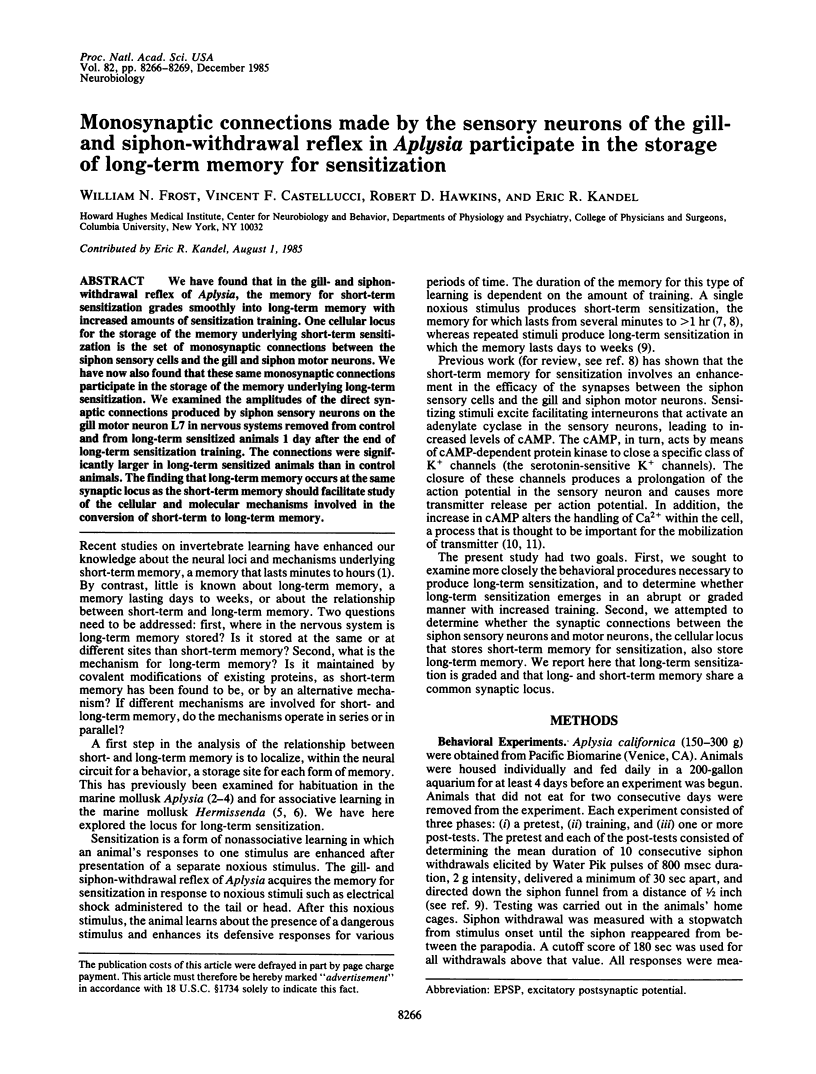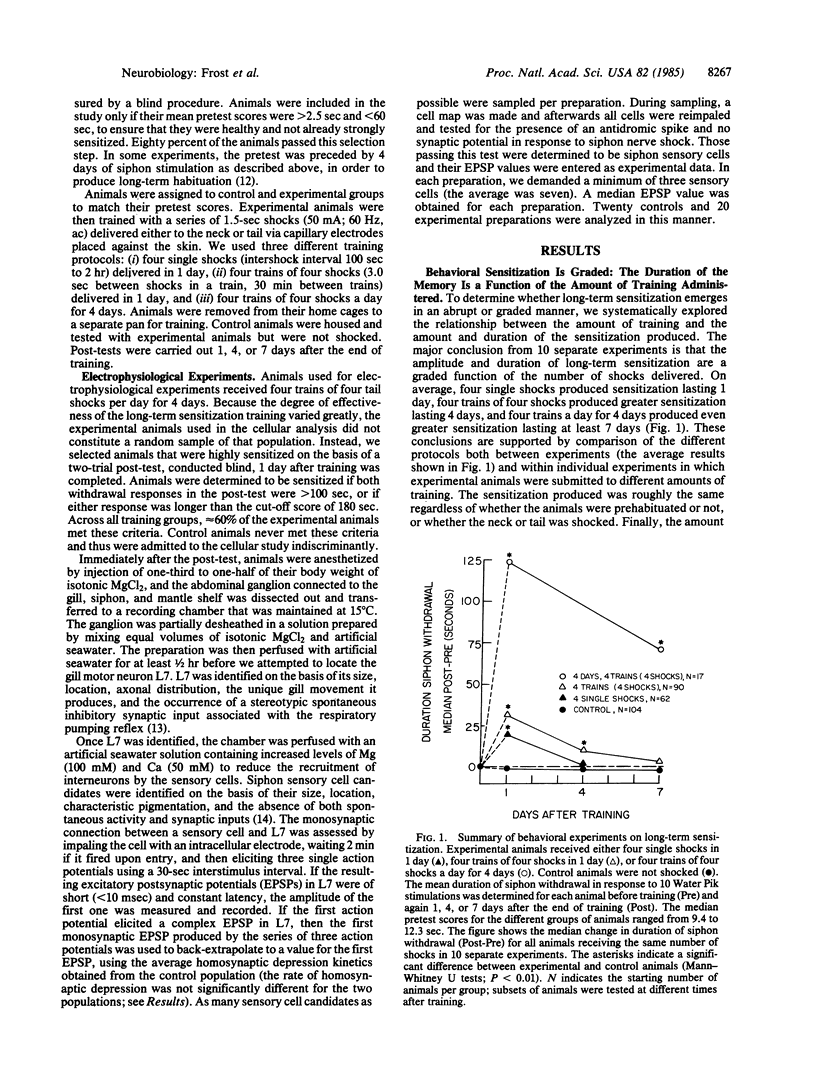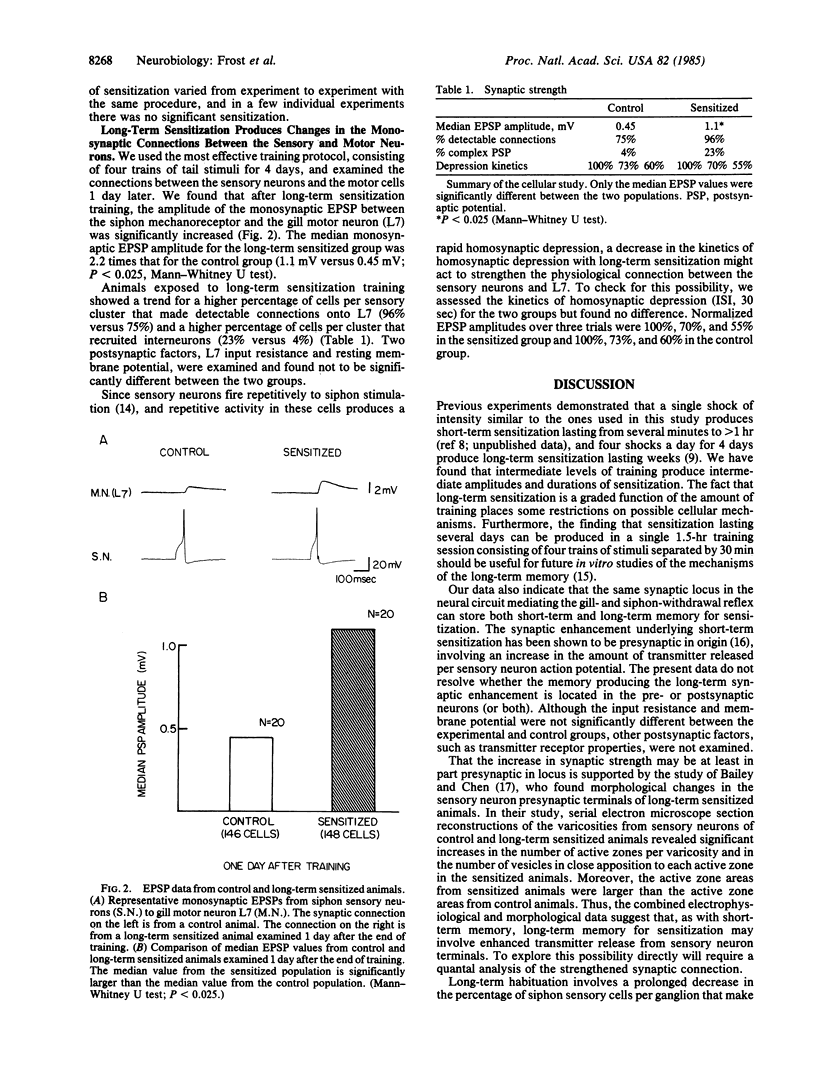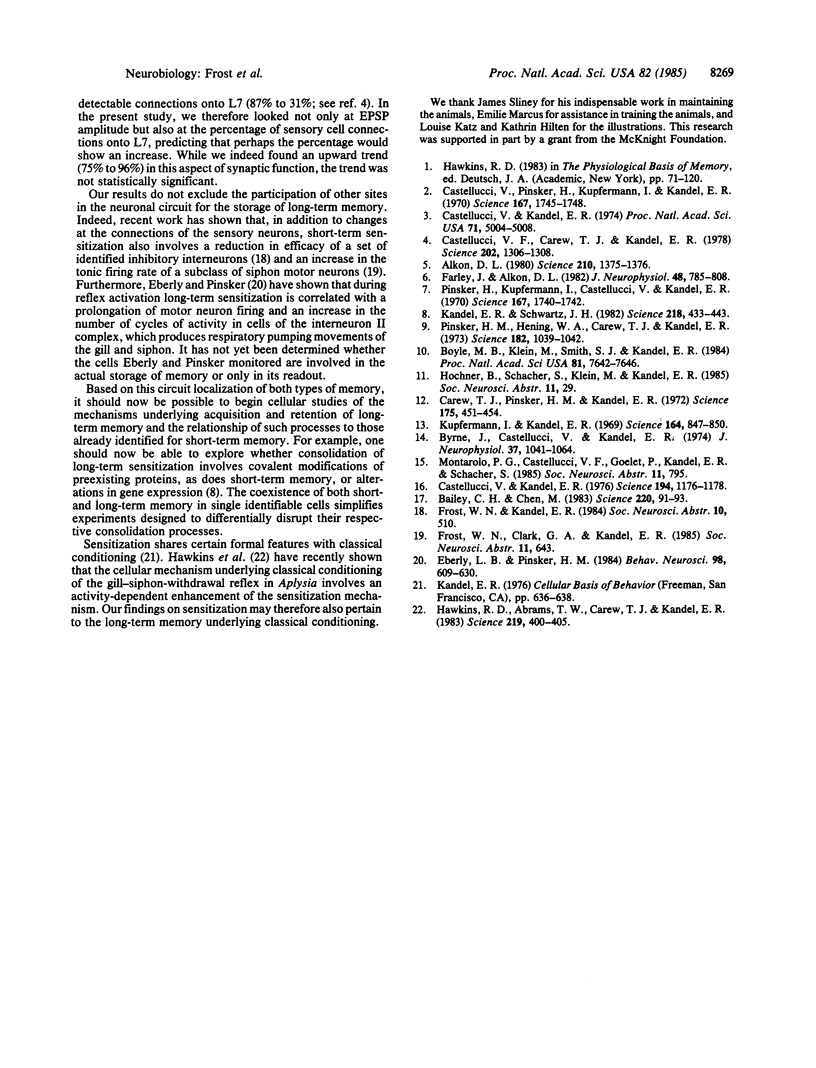Abstract
We have found that in the gill- and siphon- withdrawal reflex of Aplysia, the memory for short-term sensitization grades smoothly into long-term memory with increased amounts of sensitization training. One cellular locus for the storage of the memory underlying short-term sensitization is the set of monosynaptic connections between the siphon sensory cells and the gill and siphon motor neurons. We have now also found that these same monosynaptic connections participate in the storage of the memory underlying long-term Sensitization. We examined the amplitudes of the direct synaptic connections produced by siphon sensory neurons on the gill motor neuron L7 in nervous systems removed from control and from long-term sensitized animals 1 day after the end of long-term sensitization training. The connections were significantly larger in long-term sensitized animals than in control animals. The finding that long-term memory occurs at the same synaptic locus as the short-term memory should facilitate study of the cellular and molecular mechanisms involved in the conversion of short-term to long-term memory.
Full text
PDF



Selected References
These references are in PubMed. This may not be the complete list of references from this article.
- Alkon D. L. Membrane depolarization accumulates during acquisition of an associative behavioral change. Science. 1980 Dec 19;210(4476):1375–1376. doi: 10.1126/science.7434034. [DOI] [PubMed] [Google Scholar]
- Bailey C. H., Chen M. Morphological basis of long-term habituation and sensitization in Aplysia. Science. 1983 Apr 1;220(4592):91–93. doi: 10.1126/science.6828885. [DOI] [PubMed] [Google Scholar]
- Boyle M. B., Klein M., Smith S. J., Kandel E. R. Serotonin increases intracellular Ca2+ transients in voltage-clamped sensory neurons of Aplysia californica. Proc Natl Acad Sci U S A. 1984 Dec;81(23):7642–7646. doi: 10.1073/pnas.81.23.7642. [DOI] [PMC free article] [PubMed] [Google Scholar]
- Byrne J., Castellucci V., Kandel E. R. Receptive fields and response properties of mechanoreceptor neurons innervating siphon skin and mantle shelf in Aplysia. J Neurophysiol. 1974 Sep;37(5):1041–1064. doi: 10.1152/jn.1974.37.5.1041. [DOI] [PubMed] [Google Scholar]
- Carew T. J., Pinsker H. M., Kandel E. R. Long-term habituation of a defensive withdrawal reflex in aplysia. Science. 1972 Jan 28;175(4020):451–454. doi: 10.1126/science.175.4020.451. [DOI] [PubMed] [Google Scholar]
- Castellucci V. F., Carew T. J., Kandel E. R. Cellular analysis of long-term habituation of the gill-withdrawal reflex of Aplysia californica. Science. 1978 Dec 22;202(4374):1306–1308. doi: 10.1126/science.214854. [DOI] [PubMed] [Google Scholar]
- Castellucci V. F., Kandel E. R. A quantal analysis of the synaptic depression underlying habituation of the gill-withdrawal reflex in Aplysia. Proc Natl Acad Sci U S A. 1974 Dec;71(12):5004–5008. doi: 10.1073/pnas.71.12.5004. [DOI] [PMC free article] [PubMed] [Google Scholar]
- Castellucci V., Kandel E. R. Presynaptic facilitation as a mechanism for behavioral sensitization in Aplysia. Science. 1976 Dec 10;194(4270):1176–1178. doi: 10.1126/science.11560. [DOI] [PubMed] [Google Scholar]
- Castellucci V., Pinsker H., Kupfermann I., Kandel E. R. Neuronal mechanisms of habituation and dishabituation of the gill-withdrawal reflex in Aplysia. Science. 1970 Mar 27;167(3926):1745–1748. doi: 10.1126/science.167.3926.1745. [DOI] [PubMed] [Google Scholar]
- Eberly L. B., Pinsker H. M. Neuroethological studies of reflex plasticity in intact Aplysia. Behav Neurosci. 1984 Aug;98(4):609–630. doi: 10.1037//0735-7044.98.4.609. [DOI] [PubMed] [Google Scholar]
- Farley J., Alkon D. L. Associative neural and behavioral change in Hermissenda: consequences of nervous system orientation for light and pairing specificity. J Neurophysiol. 1982 Sep;48(3):785–807. doi: 10.1152/jn.1982.48.3.785. [DOI] [PubMed] [Google Scholar]
- Hawkins R. D., Abrams T. W., Carew T. J., Kandel E. R. A cellular mechanism of classical conditioning in Aplysia: activity-dependent amplification of presynaptic facilitation. Science. 1983 Jan 28;219(4583):400–405. doi: 10.1126/science.6294833. [DOI] [PubMed] [Google Scholar]
- Kandel E. R., Schwartz J. H. Molecular biology of learning: modulation of transmitter release. Science. 1982 Oct 29;218(4571):433–443. doi: 10.1126/science.6289442. [DOI] [PubMed] [Google Scholar]
- Kupfermann I., Kandel E. R. Neuronal controls of a behavioral response mediated by the abdominal ganglion of Aplysia. Science. 1969 May 16;164(3881):847–850. doi: 10.1126/science.164.3881.847. [DOI] [PubMed] [Google Scholar]
- Pinsker H. M., Hening W. A., Carew T. J., Kandel E. R. Long-term sensitization of a defensive withdrawal reflex in Aplysia. Science. 1973 Dec 7;182(4116):1039–1042. doi: 10.1126/science.182.4116.1039. [DOI] [PubMed] [Google Scholar]
- Pinsker H., Kupfermann I., Castellucci V., Kandel E. Habituation and dishabituation of the gill-withdrawal reflex in Aplysia. Science. 1970 Mar 27;167(3926):1740–1742. doi: 10.1126/science.167.3926.1740. [DOI] [PubMed] [Google Scholar]


